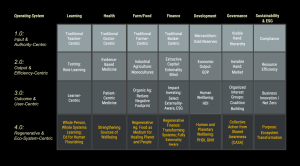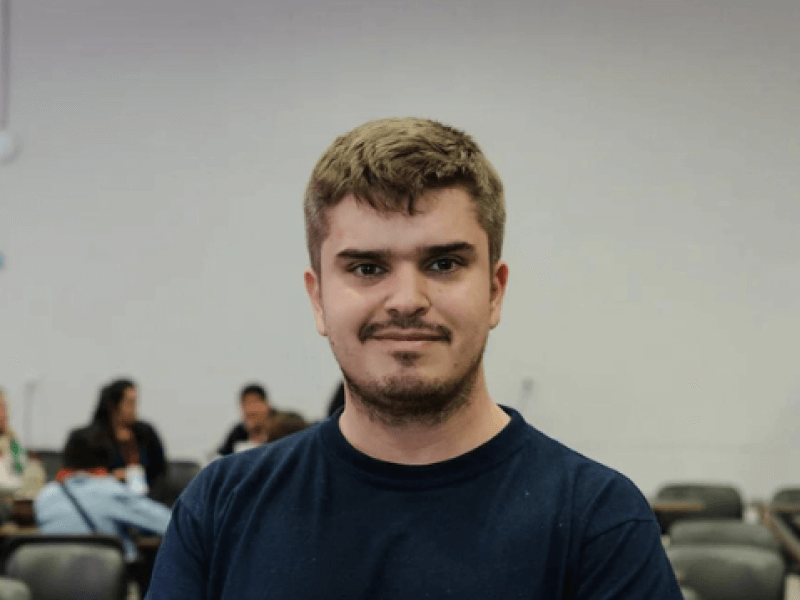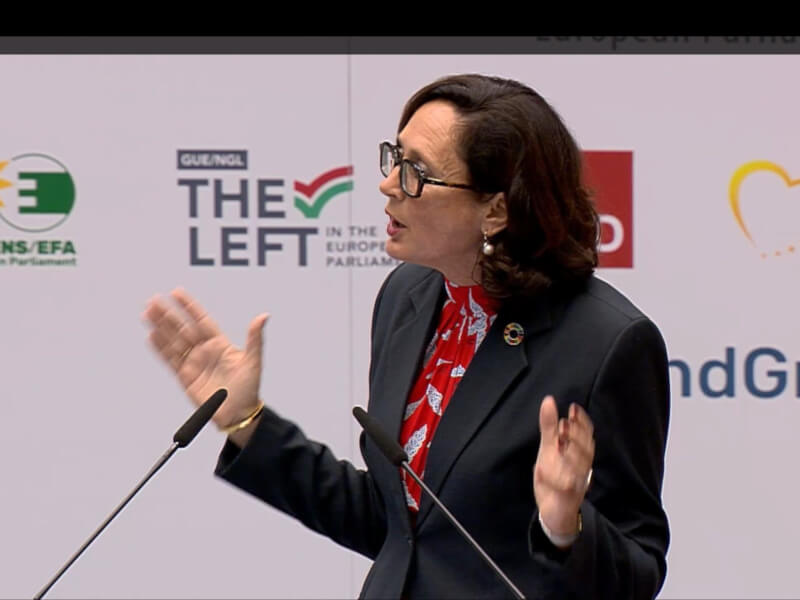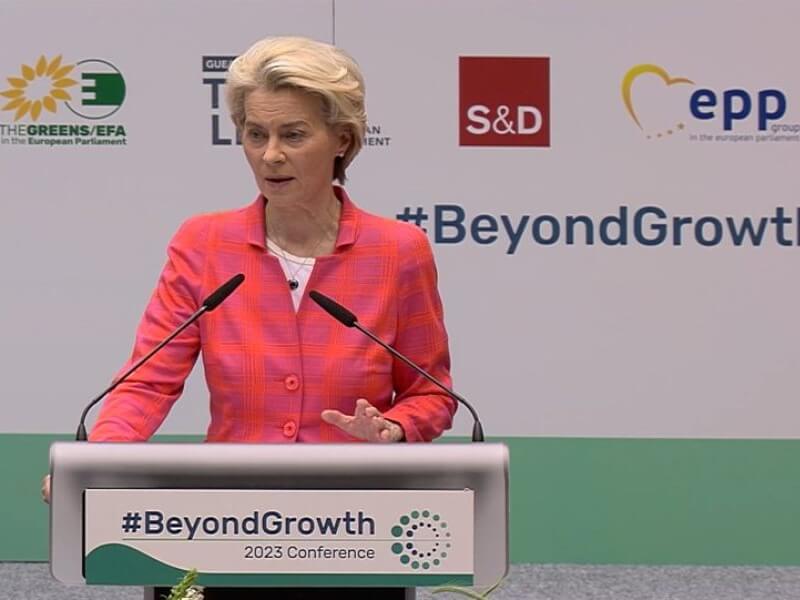03 October 2022 –
I am sitting on a train on the Räthische Railway riding back from Pontresina, high in the beautiful Swiss Alps. Surrounded by the presence of melting glaciers I reflect on two gatherings that happened here earlier in the week: the World Ethic Forum (WEF) with about 250 participants, and the annual meeting of the World Future Council (WFC), a gathering of 50 global change-makers from civil society, government, academia and business. Both gatherings were convened with the intention to reimagine our path to a future that is regenerative, peaceful and just.
As I reflect on these and other similar gatherings in recent months, I am noticing three themes. These same themes are also echoed in the upcoming UN Human Development Report 2021–2022 (to be published later this week) and in the forthcoming Club of Rome study 50 years after its groundbreaking book Limits to Growth. The new study is called Earth for All: A Survival Guide for Humanity (to be published later this month). It is a collaborative effort guided by the Transformational Economics Commission, a group of pioneering economic thinkers, scientists and activists convened by the Club of Rome.
Civilizational Collapse?
The first theme is that we are living in a time of accelerated breakdown and collapse. We see the symptoms of this in the degradation of our ecosystem, often described as “the worst in 1,000 years” in the case of floods and drought. We see it in climate destabilization, in falling water tables, in the loss of topsoil, and in the alarming loss of biodiversity. We see the symptoms of social system breakdown in heightened levels of polarization, inequality, racism, violence and war, as well as in the beginnings of climate-related mass migration.
The second theme is the sinking feeling that arises when taking all of this in. It’s a feeling that says: There seems to be nothing that I or we can do about it now — maybe it’s already too late. In other words, there exists a pervasive collective depression that shapes everyone’s outlook, in particular that of our youth, who will carry the burdens of our societal failures into the future.
The third theme has to do with the paradox that we know almost everything that is necessary to prevent civilizational collapse — we have most of the knowledge, most of the technologies, and all the financial means necessary to turn things around — and yet we are not doing it. In short: The third theme is about the massive knowing-doing gap that has been embodied in our collective behavior over the past 50+ years.
Before I go more into detail on how to transform the knowing-doing gap — including a discussion of the key findings of the Earth for All study — let’s contemplate the deeper significance of these three themes.
What do they tell us? They tell us that we live in a moment of transition where one civilization is ending and dying and another one is being born. And as custodians of planet earth and all its species, we are called to protect the flame of our highest future possibilities.
The British historian Arnold Toynbee, who studied the rise and fall of civilizations, found that civilizational structures collapse when leaders and their institutions are no longer able to creatively respond to the dominant challenges of their time. What I mean by civilizational collapse (and possibly regeneration) is a process that embodies three core features:
-
Hard Facts: We can clearly see the symptoms of accelerating social and ecological degradation, disintegration, breakdown, and collapse.
-
Collective Fields of Conversation: We see a breakdown of both the capacity to make sense of and respond to the current situation by losing the capacity for having a shared conversation about what’s happening. This issue is exacerbated by the toxic impact of dark money in politics and business models in social media-based tech companies that amplify misinformation, polarization, and negative emotions.
-
Human spirit: We see a massive spike in mental health struggles. According to the 2022 Human Development Report, one out of eight people on the planet face mental health issues. Our collective sense of helplessness prevents us from responding creatively to the current moment.
Are We Sinking? Or Are We Going to Rise?
You may know the old joke about dealing with complexity: If you’re not confused, you’re out of touch. In light of our current situation, we might say: If you’re not depressed, you’re probably out of touch. What I would like to offer here is a different interpretation of the collective condition of depression that weighs so heavily on our current moment. I see our collective condition as a sign of hope (because it signifies a departure from denial).
Here is an (admittedly anecdotal) data point. At MIT, I have often participated in group simulations with Prof. John Sterman and his colleagues in the System Dynamics Group, who run role-playing scenarios with leaders from different sectors and regions. Each participant is assigned to a team that represents key countries and interests in climate negotiations. After a period of study and discussion, each team makes proposals and decisions that are fed into a computer model that scientifically predicts the region-specific impact of those decisions for the remainder of this century. The participants can easily see the collective impact of their decisions, which almost always, at the beginning, result in disaster and collapse, reflecting our current collective behavior.
Having seen the projected outcome of their decisions, the teams then enter into a second round of discussions, negotiations, and decision making. In short, the participants’ decisions begin by replicating the current reality, but as their collective awareness rises, they SEE the impact of their flawed decision making. Slowly, their collective behavior begins to change. The evolution of the collective sense-making and decision-making patterns that I have seen on such occasions roughly follows these four stages:
-
Denial: discounting the real future impact of our decisions (“not my problem”)
-
Distancing: acknowledging the problem, but allocating the blame to someone else (“it’s their fault, not mine”)
-
Depression: after realizing that denial and distancing won’t solve anything, the sinking feeling that “it’s too late”
-
Deep Sensing & Co-creativity: managing to stay in the moment, holding your gaze steady, and then letting go (of the old) to allow new possibilities to emerge. In the simulation, this stage often leads the participants to radical new ways of collaborating and co-creating while acting from a shared awareness of the whole.
The above image by Kelvy Bird visualizes this pattern by plotting these four stages onto the U process of transformation, and it suggests that our collective sense of depression is not the end of this story. Instead, it can be the beginning of a collective journey to a co-creative response. But even if that more upbeat interpretation of our current state is correct, the big question of course remains: What does it take to move from the state of depression to that of deep sensing and collective creativity?
A Martian View of Our Collective Blind Spot
If a friendly visitor from Mars were to land in the United States today and study our collective behavior, what would she notice and what would surprise her?
Here is a pattern that, in my view, any astute extraterrestrial observer would pick up on:
-
Security: The world’s biggest military superpower, armed to the teeth and operating 800 overseas military bases in more than 70 countries, focuses all its forces on the dangers that are, supposedly, lurking off its shores. Yet, whenever the real threats and dangers hit home, they tend to originate from within (examples: the 9–11 terrorist attacks; the January 6 attack on the Capitol; climate-related security risks; attacks on civilians by armed citizens).
-
Health Care: The wealthiest country on the planet has some of the worst health outcomes with sinking life expectancy even before the pandemic. In 2019, the American Academy of Pediatrics issued a report noting that ‘mental health disorders have surpassed physical conditions’ as the most common issues causing ‘impairment and limitation’ among adolescents. Even though the main source of threats has shifted from external (accidents, drugs) to internal (mental health), the current system — the training of health care professionals and emergency responses — is still focused on those external threats.
-
Economic governance: All modern economies rely on the division of labor. It’s the key to productivity. But it comes with a coordination challenge. How do you stitch the whole back together after the division of labor has pulled it apart? Thus far we have relied on two powerful exterior mechanisms of coordination — the invisible hand of the market and the visible hand of government. For a period in history, the power of trade unions served to mediate these forces at least for some of the stakeholders. But what our observant Martian researcher surely would pick up on is that neither of these traditional mechanisms alone is sufficient to deal with today’s challenges.
Our coordination mechanisms need to evolve. Instead of only relying on external mechanisms, we need to interiorize the collective impact, we need to coordinate and act from a shared awareness of the whole. I call this Collective Action from Shared Awareness (CASA). A first step into that direction of consciousness-based systems change was taken with the launch of the Inner Development Goals (IDGs) earlier this year in Stockholm as a complement to the Sustainable Development Goals (SDGs) in order to build transformative capacities to bridge the knowing-doing gap.
The Martian researcher might write in her notebook that she sees a stunning mismatch between form and function of the institutions that are supposed to support the well-being of our citizenry. That mismatch represents a critical developmental challenge of our time: across all systems we need to close the form and function, or what we have called the knowing-doing gap. What we have learned is that closing this gap requires us to reconnect with a profound human aspiration and capacity for inner development and living in harmony with our planet and with each other; by applying this aspiration and capacity to the transformation of our institutions, our societies, and our relationship to land. And this can only happen if we deepen our interiority or, in other words, interiorize externalities (i.e., our blind spots) so we can more appropriately respond to the challenges of our time.
Protect the Flame
So, back to the big question: Are we sinking, or are we going to rise? In my view, the answer depends on whether or not we try to, and succeed in, creating new types of societal learning infrastructures for transformation — infrastructures that connect to and activate this human capacity for individual and collective transformation.
At the World Ethic Forum, the first two days started with a small holding circle of about 50 people who were referred to as firekeepers. When it was my turn to share, I talked about a moving moment from my student days. I had watched Joseph Beuys accept the Wilhelm Lehmbruck Prize for sculpture in 1986. It probably was the last public speech Beuys gave, shortly before his passing. He spoke about the flame of inspiration Lehmbruck had provided for Beuys’s entire artistic body of work. He closed his speech with the words, “Protect the Flame!” — Schütze die Flamme! These words struck a deep chord.
In that moment I felt as if that small flame, that represents the essence of the human spirit, completely depends on people like us who receive it, protect it, and then pass it on to the next generation. When Beuys ended his speech with that line — Protect the Flame! — I felt as if I too had just received the flame, perhaps in a similar way as he did many years earlier. Protect the flame is quite different from, say, carrying or waving a torch. What I saw with my inner eye looked more like a candle: you hold the candle in one hand, and you protect the flame with the other — by holding it very close to your heart.
And that may well be what is necessary today. Because our planetary emergency is already so fragile, each of us needs to hold and protect the flame by holding it close to our heart.
Three Transformations
What’s most systemic is most personal and interpersonal is what my MIT colleague Peter Senge likes to say. It’s something that Joseph Beuys, who originated the term of social sculpture–by which he means the totality of all relationships that we as humans enact–would deeply resonate with. In that spirit I want to now invite you to go to the opposite end of the spectrum: the macro-systemic angle. To adequately address our current polycrisis, there are at least three macro-level transformations that, in my view, need to happen. We need to transform:
-
Our economies from ego to eco
-
Our governance from top-down to distributed & dialogic
-
Our educational systems from output or testing driven to generators of a better future
1. Transforming Our Economies from Ego to Eco
A possible pathway toward this economic transformation will be presented in the new Club of Rome study at the UN in New York later this month. It focuses on five major turnarounds:
Eliminate poverty: Extreme poverty has declined dramatically in the last fifty years. But still almost half the world lives in poverty, surviving on less than US$4 per day. The turnaround:
-
Create new “Special Drawing Rights” to allocate over US$1 trillion per year to poor countries to invest in the creation of regenerative economies (actionable by the IMF).
-
Intellectual property rights waivers for patented renewables and health technologies (actionable by the WTO).
Reduce inequality: In many countries, the income of the richest 10% accounts for more than 50% of the national income. This is a recipe for deeply dysfunctional and polarized societies. The turnaround:
-
Progressive taxation and closure of international tax loopholes
-
Citizens’ funds to give everyone their fair share of a nation’s wealth (Universal Basic Dividend)
Empower women: Massive investment in education and empowerment for girls and women. Example: According to the Food and Agriculture Organization of the United Nations, if all women smallholders receive equal access to productive resources, their farm yields will rise by 20 to 30 percent. 100 million to 150 million people will no longer be hungry. The turnaround:
-
Increase education access for all girls and women.
-
Achieve gender equality in leadership positions across institutions.
Transform food systems. Industrial agriculture is one of the biggest sources of greenhouse gas emissions, deforestation, soil and biodiversity loss, and water pollution. The turnaround:
-
Eliminate all harmful subsidies to industrial agriculture (almost 90% of the 540 billion dollar annual farm subsidies are harmful to people and planet, according to a recent UN report).
-
Reduce food waste and promote healthy plant-rich diets.
Transform energy systems. The Paris Agreement’s goal to limit the global temperature increase in this century to 2°C above preindustrial levels requires approximately halving greenhouse gas emissions globally every decade from 2020, to reach close to zero by 2050. The turnaround:
-
Redesign and phase-out fossil-based energy systems.
-
Increase energy efficiency, reduce consumption
-
Electrify everything, powered by renewable sources.
2. Transform Governance from Top-down to Co-creative & Dialogic
All of these measures are doable, and they are self-reinforcing, as the underlying simulation model of this study demonstrates. The necessary resources are also readily available. The cost estimates for achieving the planetary emergency-related turnarounds range from 2 to 5% of global GDP. By comparison, in national emergencies like war, governments often mobilize up to 50% of their GDP. So, if we have the resources, and the solutions, why aren’t we putting them to work?
The answer to that question has to do with governance. Our current decision-making structures often operate under the lopsided influence of organized interest groups which favors small groups that can organize easily (such as a monopoly industries) over big ones that cannot (those that work for the interests of all citizens), and that favor citizens with a voice (current generations) over those with no voice (future generations and the planet itself). The push for transformation has also activated a notable backlash from some special interest groups. Exhibit A is the creation and massive funding of the climate-denial industry which, in the United States in the early 2000s, succeeded in reversing public support for a carbon tax (source: Dark Money).
So the problem we face is that even though 3 out of 4 citizens in G20 countries support transformational changes to combat social inequality and climate change, our current governance systems are not delivering on that. What gives me hope in this moment is that many decision makers in government and business privately agree that these transformative changes are necessary now. They personally would like to be part of a different story of the future. But they don’t know how.
All governance is about geometries of power. The question is to redesign and evolve our democracy and governance systems in ways that make the widely shared aspiration for transformative change — which we witness today in most countries — relevant for collective decision making.
One of the first examples for venturing into this new territory is what is now happening in Chile. In Chile, more than 80% of citizens are in support of a new constitution. But then, when the proposed new constitution was voted on last Sunday, more than 60% did not support that proposal. So, more conversation and a better supporting infrastructure for true dialogue — thinking together across different viewpoints and ideologies — is necessary to reimagine and reshape the future in a way that serves both human and planetary flourishing. What has been happening in Chile is a harbinger of what is to come also for other countries: a (potential or actual) breakdown of social order, followed by a renegotiation and reimagination of a new social contract.
The underlying question is how can we evolve our democratic decision-making and governance structures in ways that make them more distributed, dialogic, and direct?
3. Transform Learning & Leadership to Create the Future
To make this work we need to transform our education and lifelong learning systems. While we have evolved from rote to more learner-centric modalities in many places, education continues to focus on individual learning and capacity building. We are a far cry from educational models that build the capacity for co-sensing and co-shaping the future.

Figure 2: Four Stages of System Evolution, Four Operating Systems (Source: Scharmer, 2018)
Figure 2 shows how the evolution of our institutions of education and learning (column 1) dovetails with the evolution of all the other sectors (health, food, finance, development, governance, and civil society). In all these sectors we see the same story playing out:
- Moving from an old operating system based on output and efficiency to a newer one that is based on outcomes and user experience, and
-
Moving from there to an emerging future operating system that is based on regeneration and ecosystem awareness.
Each of these fundamental shifts requires the adoption of a new operating system that follows new rules and is grounded in a different paradigm of thought and set of collaborative capacities.
The most important systems challenge today is trying to solve 4.0-type problems with response mechanisms that are still bounded by 2.0 and 3.0 ways of operating.
Which brings us back to learning and leadership. What holds us back from moving more fully into 4.0 ways of operating are three main barriers:
-
A lack of institutional infrastructures that bring together all relevant players in order to co-shape and co-navigate the system.
-
A lack of leadership tools and capacities for shifting the awareness of the various stakeholders from a silo to a systems view — i.e., from ego to eco.
-
And a lack of financial mechanisms to fund and scale the above.
What again is our path to closing the knowing-doing gap? It’s to remove these three barriers. We need to shift to 4.0 ways of operating in order to truly transform our economic, governance, and leadership systems, in order to release the deep desire we share as human beings to live in harmony with each other and with our planet.
But these transformations will not happen by themselves. They will only happen if supported by new societal learning infrastructures that are scalable, place- and region based, and that use personal transformation as a gateway for systems transformation.
Circles of Radical Presence
As I complete this, my train has long since arrived in Zurich and my return flight has started the descent into Boston. Let me close with this question: How is this really going to work, if it ever does? The “this” being: the transition from one civilization that is dying, to another one that is being born.
We know the path forward will not be easy. We know that the solution to our problems in this century is not Big Government. It’s not Big Money. And it’s not Big Tech either. Of course, we do need all three — government, capital, and technology. But what we need most of all is a profound shift in our qualities of relationship that allows us to protecting and tending the flame.
When systems collapse, what are we left with? We are left with each other. We are left with our relationships. With how we relate to Mother Nature, how we relate to each other, and how we relate to our emerging Selves. These are our three sources of protecting, tending, and cultivating the flame.
If that is true, then the single most important leverage point for progressing on our collective journey of transformation is the creation of enabling infrastructures that support leaders, citizens, and communities in transforming their relationship from extractive to regenerative by shifting the underlying consciousness from ego-system to eco-system awareness, that is, from a silo- to a systems view.
At the Presencing Institute we have experimented with building and scaling these types of awareness-based learning infrastructures over the past 15+ years across a variety of societal acupuncture points, involving more than 200,000 change-makers in more than 2000 hubs across all sectors and geographies. If that work is of interest, join our free online u-lab starting later this month. It functions as a portal for the u-school for transformation — which is an early prototype for a multi-local learning infrastructure at the intersection of science, art, consciousness, and the praxis of transforming systems and self.
We all want to act but often it’s unclear how. Maybe the one thing we can do is to prototype this enabling infrastructure for sensing and actualizing the emerging future through forming small circles of radical presence — as a holding space for supporting each other in protecting the flame of our — and our planet’s — highest future potential at this juncture of existential risk. It’s these fields of deepened connection — of radical shared presence — that can support the healing and can function as the soil and seed for a new civilization to emerge.
First published in Medium






